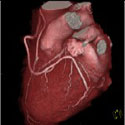

I'm presently attending the Society for Cardiovascular Computed Tomography meetings in Washington, DC, along with 500 of my colleagues. It's exciting to see how interest in CT scanning for heart disease has balloonned in the past couple of years.
Several trends are noticeable today, based on the content and tone of the discussions:
--CT scanning of the heart, and imaging in general, is just getting started. In other words, the capabilities for CT scanners and other devices to detect heart disease (coronary and otherwise) are where the gasoline engine was in the 19th century. Scanning is getting faster, easier, safer, and more precise. Just as few people in 1905 could have predicted that automobiles would be computer-enhanced, high-speed, ubiquitous devices with several per household, the potential for CT imaging for heart disease is truly in its infancy.
--CT coronary angiography (so-called "64-slice CT scans") are not screening tests for hidden coronary disease in people without symptoms. I was grateful that this point has been made and reiterated by several speakers, as this is consistent with our views. Simple CT heart scans for coronary calcium scoring, in contrast, are screening tests. When the radiation exposure of CT angiograms are reduced to tolerable levels, then they may be used as screening tests. We are probably 3-4 years away from this point.
--Both stress testing and heart catheterizations will be partially replaced by CT scanning. In particular, over the next decade, you will see a dramatic drop in unnecessary catheterizations, i.e,, far less people saying "I had a heart cath but they told me that it was normal."
There has been heavy focus on applications of CT scanning for acute settings, particularly the emergency room and hospitals.
What has surprised me is that there is virtually no conversation whatsoever about the preventive uses of CT heart scanning. So far, only Dr. Daniel Berman of UCLA has shown that he has "seen the light": CT scans are a crucial tool for identification of early coronary plaque, and this tells us whether prevention is necessary and with what intensity.
There has been, however, no discussion at all about quantification of plaque in a program of reversal . Perhaps that should come as no surprise, given the imaging-technology focus of this convention. For most of my colleagues, prevention is also not terribly interesting. Identification and treatment of acute disease like impending heart attack is.
Of course, applying the information from your CT heart scan to empower you in a program and reversal is what the Track Your Plaque program is all about. I hope you see the light. I admit that it's not always easy to follow what we are advocating here. Perhaps not too different than telling someone in his horse-drawn buggy that one day he'll be driving a sleek car with onboard computerized mapping, air-conditioning, and micro-chips to modulate engine performance. He's probably tell us we're nuts.
I'll continue to update if any news relevant to our interests crops up in these meetings.